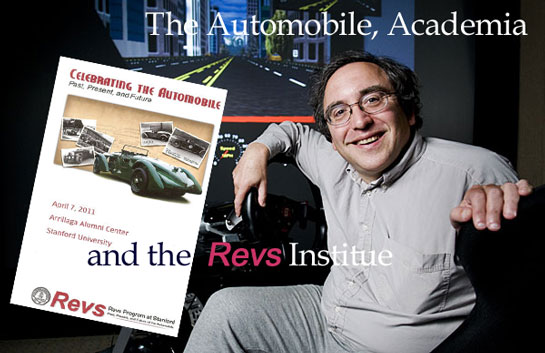
Dr. Clifford Nass is seen at the wheel of an automobile simulator in the Communications at the Humans and Interactive Media Lab at Stanford. He is the Director of the Revs Program at Stanford.
Lynch explains goals of the Collier Collection and the new Revs Institute at Stanford
By Michael T. Lynch
As an enthusiast, I’ve often wondered over the years where the automobile went wrong with Academia. Although the automobile has had a huge impact on many intellectual disciplines, little scholarly work has been written about it that wasn’t negative. Certainly cars have had deleterious effects on society – pollution, urban sprawl and fatal accidents among them — there have been positive aspects as well. When I left the Midwest to go to school in the Northeast, it occurred to me that in centers of intellectual inquiry like New York, Boston, New Haven and Philadelphia, these cities all had working mass transportation systems. Many people didn’t even own cars, simply renting them for occasional weekend excursions. Intellectuals operating in these public transportation hothouses could only see the evil in the automobile, not considering what a miniscule portion of our population is served by even minimally-effective public transportation. Certainly the automobile is positive in that a huge percentage of American workers could not get to their jobs without one and would have no ability to start a new job, if they lost one.
Working backward, I considered the bifurcated American public education system, where for many decades, smart kids in high school were put on a college track and those deemed slower learners were relegated to what was usually referred to as “shop” – technical training. Shop usually contained an automotive component, so when intellectuals proceeded forward with their education, they already had a built in bias – cars and dumb kids were associated in their universe. The automobile certainly wasn’t a legitimate object of intellectual inquiry. The suburbs that our middle class fled to after World War II could never have been built without the availability of the automobile. At the same time, our national priorities have been skewed by the automobile in ways that were certainly not in the national interest. Without intelligent inquiry on both sides of the issue, the general public is left out of public policy discussions of how we can change our use of cars for the better.
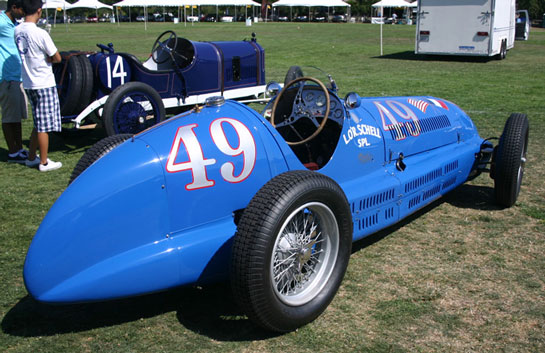
This Maserati 8CTF from the Collier collection was displayed at the Revs Institute at Stanford tent at the Palo Alto Concours. The car ran in European Grands Prix and three times in the Indianapolis 500. It also finished second in the 1949 Pikes Peak Hillclimb. It is shown in the livery of its 1940 Indianapolis entry. Behind it is the Collier’s 1913 Peugeot. This car represents the beginning of the modern racing car. It has both dual overhead camshafts and hemispherical combustion chambers, an engine architecture that endures today in real racing engines.
Recent developments that began in the enthusiast automotive community may have the effect of moving academia toward a more balance view of the automobile. Rolling back the rock is a visionary collector, Miles C. Collier.
Collier is American racing royalty in that his father, C. Miles and uncles Sam and Barron were founders of the Automobile Racing Club of America in the 1930s. The club’s stated purpose was to revive European-style road racing in America at a time when all top line racing here was conducted on ovals. The Colliers also became the MG importers and C. Miles raced in Europe a few times in the 1930s, an extreme rarity for an American at the time.
Although the ARCA wasn’t always either an artistic or financial success, some impressive events were held with members entering European GP machinery. The real contribution of the Colliers was to have the vision to promote road racing in America when there was none. The ARCA was shut down after Pearl Harbor and never revived. However, after World War II, several members including George Weaver, C. Miles and Sam were influential in turning the fledgling Sports Car Club of America’s mission from preserving older sports cars to promoting racing. Within a decade, sports car racing became a major sport in the U.S. with some SCCA events rivaling the Indianapolis 500 in attendance.
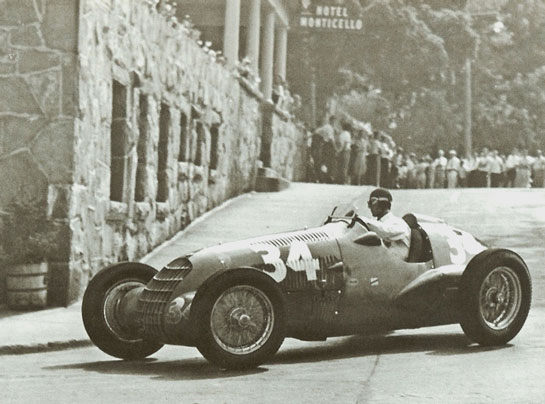
This is not Italy. By the end of its run, ARCA members had some pretty serious cars. This is Dick Wharton on his way to victory at Alexandria Bay New York in 1940. The car is an Alfa 308 Grand Prix car.
Miles C. Collier became interested in road racing and he first built an important collection of Porsches which he raced in vintage events. At the end of 1986, he bought the collection of sportsman Briggs Cunningham, who had been an early road racer and an associate of his father and uncle, Sam. Some of the cars Miles acquired from the Cunningham collection had been raced by his father and uncle.
As Collier culled the collection over the years and added to it, he developed strong theories on the responsibility of collectors to form a rationale for their collections and to preserve the past. In a world of over-restored cars, Collier became a voice of reason. Collectors slowly came his way and major concours began to mark cars down for over restoration. This gave less credence to “trailer queens”, cars that are trucked from show to show, but are never driven. Slowly, barn finds were only cleaned up rather than receiving a ground-up restoration and major concours began having classes called “preservation” or “survivor” to accommodate them.
By 2000, Collier began a series of biennial symposiums on collecting. These included faculty like historian Doug Nye, driver/historian/restorer Phil Hill, restorer Paul Russell and others at the top of the collector car world. Guests were limited and the attendance was mostly made up of significant collectors who came away with a new appreciation of their responsibilities.
In 2009, the Revs Institute was founded as an educational institution. Miles Collier said, “The idea is to add intellectual and academic stature to the study of the automobile, and recognizing that we had an asset here in the form of a special library collection that really was one of the preeminent research engines in the world for the history of the car, we ought to make that available to serious researchers, academicians and other kinds of students of the automobile. That’s what the Revs Institute is all about; making this special collections library available to people.”
Since then, Miles has expanded what he wants to achieve, which seems to be nothing less than the acceptance of the study of the automobile at the highest levels of academia. That led to the Revs Program at Stanford which was launched earlier this year through an eleemosynary arrangement between Collier entities and Stanford University. 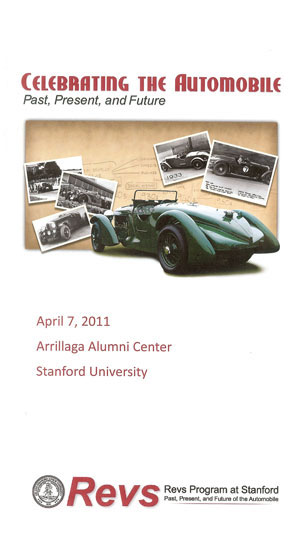 On April 17th, a symposium entitled “Celebrating the Automobile, Past, Present and Future was held at Stanford. Speakers included scholars from the following disciplines; Archaeology, Communication, English, Humanities, Law, Mechanical Engineering, Medicine and Psychiatry. There was a racing dialog that included ALMS team owner Duncan Dayton, vintage racer and promoter Murray Smith and a Stanford undergraduate racer, Julia Landaur. There were also people from Dr. Michael Shanks’ Metamedia Lab and the Stanford University Libraries. Subjects touched on the past, present and future of the automobile.
On April 17th, a symposium entitled “Celebrating the Automobile, Past, Present and Future was held at Stanford. Speakers included scholars from the following disciplines; Archaeology, Communication, English, Humanities, Law, Mechanical Engineering, Medicine and Psychiatry. There was a racing dialog that included ALMS team owner Duncan Dayton, vintage racer and promoter Murray Smith and a Stanford undergraduate racer, Julia Landaur. There were also people from Dr. Michael Shanks’ Metamedia Lab and the Stanford University Libraries. Subjects touched on the past, present and future of the automobile.
To try and comprehend how the automobile intersects with these various disciplines, I recently spoke to the Director of the Revs Program at Stanford, Dr. Clifford Nass, the Thomas More Storke Professor at Stanford University, with appointments in communication, computer science, education, law and sociology.
I asked what he saw as some of the Program’s first initiatives. He said he, “…wanted to bring the automobile to the center of the university, appearing in research and in courses of every discipline.”
Because the automobile has had such a profound effect on technology, society and culture, Nass “…finds it remarkable that academia ignored the automobile as a subject of study and relegated it to lower pursuits.”
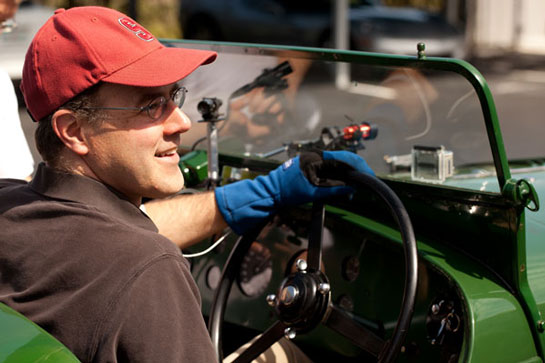
Associate Professor Chris Gerdes of Stanford has his sensors on as does the Bentley and he sets out for a ride that will document the car's and Chris's reactions by telemetry.
One of the first exercises undertaken has been to develop what the Program is calling an “auto-biography” of selected cars. Nass says this, “…is an effort to fully understand an automobile from the vantage point of different disciplines. We are attempting this through studies as varied as determining the provenance of the vehicle to placing sensors on the car to determine handling characteristics to using EKG and skin conductance to measure how the driver is responding to the car’s performance.”
The Revs Program at Stanford’s long term goal is to, “Create a picture of specific worthy cars that can be recreated through simulation. With 3D systems making such rapid progress we might be able to allow a person to not only experience what the car looks like and feels like, but also to create a social and cultural background that would give the driver the feeling for the historical context. Also, by collecting such data we might be able to create a data base that would allow us to draw some conclusions on why certain cars became icons while others did not inspire people.”
Another initiative is support the creation of new automotive-related courses across the curriculum. The positive response from faculty in a variety of disciplines is highly encouraging.
Perhaps of most interest to the Veloce Today audience is the Revs Institute archive, which added the images of the Karl Ludvigsen Collection earlier this year. Ludvigsen is a journalist, auto industry executive and consultant who was at major races, factory visits and important auto introductions during his career. He also had the foresight to buy the collections of photographers who worked both earlier and later than he did. The Revs Institute is working with Stanford Libraries toward getting the entire Collier archive online for researchers and other qualified people in digital form.
In the immediate future, Nass and his fellow faculty and students will be involved in the feast of cars and car-related events during the week-long run up to the Pebble Beach Concours d’Elegance. During the pre-Reunion weekend and the Rolex Monterey Motorsports Reunion, the Revs Program at Stanford will have a booth in the paddock area to enable people to learn more about the program.
The Collier Collection will have two Porsches entered at the Rolex Monterey Motorsports Reunion. One of the new features of the Reunion is a section of the paddock known as the Showcase Stage. It will have a ramp and significant cars will be described by informed hosts and personalities from each car’s past. I am happy to say that I will be one of those hosts and on the Saturday of the Rolex Reunion weekend we will bring the Collier Porsche 356 Abarth Carrera up on the ramp. This is not just any Abarth Carrera, but the first one built as a factory race car. It won its class in four Sports Car World Championship events including Le Mans.
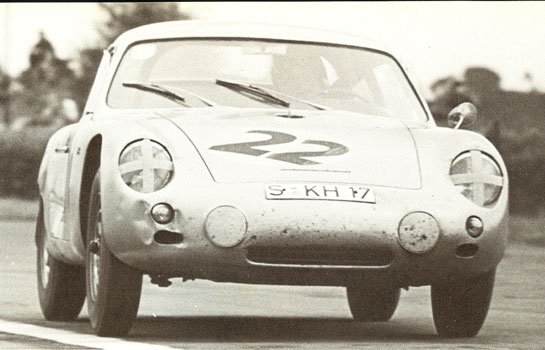
This is the Collier Porsche-Abarth 356B Carrera GTL that will be at the Rolex Reunion. It is seen in at Goodwood in 1960, where it won the GT Class with Graham Hill and Huschke von Hanstein.
When the Abarth is on the ramp, I am hoping Dr. Nass and some of his associates can tell the crowd much more about the Revs Program at Stanford than I can impart in these few words. Certainly we can all agree that this is a long overdue and noble effort.
The Revs Program at Stanford’s website is http://.revs.stanford.edu.
This link at the bottom of the page does not work. Is it correct?
Thanks
Erik, you are correct but we have fixed the problem. Note there is no www. in the url.
Ed.
Words leave me almost speechless after reading this drivel. The Collier Collection is the height of eliteism allowing only a select few of the cars to ever be seen by the public. A collection that was once totally open to the public when owned by Briggs Cunningham is now a closed shop to all but those deemed fit by this elitist horder.Briggs must be rolling in his grave.Years ago when I had the pleasure to meet Mr. Cunningham he could not have been more cordial.Allowing me full run of the collection. Now, I find it closed to all but those chosen as the insiders of the car collecting hobby.
As far as academia is concerned, I am sure it has only now dawned on them that here is one more opportunity to obtain more grants for there useless studies that only work to gain them tenure in their profession. These selfserving academics tend to be left wing to the extream and want to decide everything that you should or should not have access to. They love ultimate control and this is the same thing I see in many top collectors. It really is all about money and power. Control is everything.
Sorry to see that the Ludvigsen collection has fallen prey to these people. The statement about now being made available to those deserving access as deemed appropreiate by the institute is most telling. The public will now only have access to to what academia sees fit for you. The Collier Collection is really open now to the “public” only enoungh to make sure it preserves it’s cherished tax status. Another feather in the cap of closed eliteism. Maybe they should, for once, try to understand that without those shop classes and that great unwashed group who serve the automobile that they still want to look down on,there would be no automobile or any of it’s supporting industries nor the collector car world. They are the doctors that have kept the heart beat of the automobile alive, not an academic. Acedemia,stay the hell away from my cars.We don’t need you!!
Hopefully we all agree that the proper preservation and correct restoration of the automobile is important. This includes keeping in mind that cars are meant to be driven. I try to look at both sides. Bob Graham has presented one side, the important need for skilled workers and open access to collections and archives. He puts Miles Collier on the other side. However, without such major collectors, many great cars would be lost forever and many jobs for skilled workers would not exist.
I can’t comment on archive access except to note that the Detroit Public Library lost much of their valuable auto reference material to open access. But I will say that literally all major collectors, including Miles, are quite willing to share their cars with the public through the many concours, vintage racing and rally events.
I also knew Briggs Cunningham and his open approach was a joy. So were the early days of the uncrowded Monterey Historics and leisurely Pebble Beach. However, the world moves on and there is no going back to the 70s. I am heartened that proper preservation is getting more attention. It has been a longtime passion of mine and all of us have an important part to play for the benefit of future generations.
Ed Gilbertson is the Chief Judge at the Pebble Beach Concours d’Elegance.
[Ed.]
Mr. Graham, I suggest you be careful using the word, “drivel”. Your triple tirade against leaders in automotive preservation could stand some adjustment, as noted by Ed Gilbertson. To quote him: “The world moves on” and cars “are meant to be driven”, plus treated with “proper restoration and correct preservation”. You’re out of touch, Bob.
These activities depend upon dedicated and visionary people whom you consider to be “elitist hoarders”. Miles Collier was the true ‘needle inthe haystack’ in 1986 when Cunningham at 79 years was ready to sell his collection; literally, as the tireless tax people were ready to pounce. The cars from the Cunningham Collection comprise 48 of the 110 cars now in the Collier Collection. The remaining 25 vehicles were sold otherwise.
Your accussation of a “closed shop” regarding the Collier Collection is off base. The Collier Automotive Museum was open to the public for a modest fee from 1988 to 1993, operating as a 501 (C)(3) educational institution. I.R.S. ruling led to closure, just as it had in 1955 with Cunningham Motors.
Public display of the Collier cars has been well publicized in the motoring press, from many points in the U.S. to Goodwood. The cars are raced frequently (and ocasionally wrecked) by qualified drivers. The Collection facility is toured regularly by marque clubs and automobile personalities. More significantly, the cars are under a continuing scrupulous program of exacting preservation/ restoration by many of the best craftspersons available. Dedication at its highest level, Bob; not “hoarding”.
Your tirade against academia may have some support, but you seem to disregard it place as endowedcenters for future learning and exploration. The collaborative program between Stanford and REVS Institute, while supporting these activities, also provides hope for preservation of priceless archives. Consider an academic tax status to be an enabler rather than a restriction.
Your lament about the Ludvigsen Library acquisition is also mis-placed. The previous location in England was scarcely ‘handy’ to American enthusiasts, and its new home at REVS Institute is an excellent fit for the future. Karl himself at age 77 had no qualms about the transfer. The REVS web site will provide a full catalog and access, just as it does for the Collier archives. Take a look. Ed Gilbertson’s remark about the Detroit Public Library’s losses resulting from ‘open-ness’ deserves particular attention.
Sorry, Bob. You DO need academia – If the objects of your interest in cars are going to be around for your grandchildren to learn from and to enjoy. By the way, check out the McPherson College (Kansas) program in automobile restoration if you’re looking for hope on the technical side.
The Revs Program is to be commended for taking a more pervasive look at the role of the automobile and our relationship to that chariot within our culture. The multi-disciplinary faculty & researchers should expand our knowledge of why we love the automobile, the thrill we get from racing, the pleasure we feel in seeing the beautiful lines of a fender, hood, and how we like the roar of an engine and the wind out of a gear box. From Stanford we expect to learn from the best…I anxiously await what they will be sharing with us…from their library holdings to meaningful monographs on esoteric thoughts about wheels, with some Bay Area events that we can participate in, plus some seminars to attend. Now if we could just get Miles to move his collection to California, that would be a perfect day!
I thoroughly enjoy Veloce today,however, when I see a member of the academia using poor English, I despair.
The words ‘in that’ appear in the first paragraph when they should be substituted by ‘as’, and they appear again in the fourth paragraph when a simple’comma’ would be more correct.
Editors world wide should remove the inappropriate use of the word ‘in’
Graham,
We appreciate your help; however, neither the author nor the editor are members of Academia.
Editor
With all due respect in the comments above there is some unfair hearsay about the National Automotive History Collection at Detroit Public Library. I reveal that I was for many years the Curator of the National Automotive History Collection and currently am a staff member of the Revs Institute in Naples Florida.
The NAHC has certainly NOT “lost much of their valuable automotive reference material” to theft. It is an internationally valued and treasured historical resource. For the record the collections are housed in a closed– as in secured– stack area to which the public is not allowed access. To read a historical document or look at a photo file in the NAHC a visitor must present a picture ID and sit at a reading room table under the watchful eyes of security cameras and security officers. My former colleagues are extraordinarily dedicated and helpful and they care greatly for the collections and the public that reads the material.
Still bad English, whoever writes it, but I will still read Veloce Today.
This sounds fantastic. Do you know of a similar program in Europe?
I always wonder why the Automobile here in Germany has such a bad image whilst we produce some of the wolrds cars.
Dear Mark,
I guess my age is showing. My reference to document theft at the Detroit Public Lebrary was based on things that happened over 30 years ago. I am glad to hear about the security measures that have been taken since that time.
Regards…Ed
Dear Ed:
Thank you very much for this clarification.
Best, Mark Patrick
I have to agree with most of what Bob Graham wrote. What good is a “scrupulous program of exacting preservation” if only a very select few ever get to see the cars? I was lucky enough to have toured the museum once when it was still open to the public and have wished many times that I could visit it again when I’m in Florida, but it hasn’t been open for a long time. Like thousands of “car nuts” in the street, I’m not a member of any club, Monterey, Goodwood and Pebble Beach are far out of my travel sphere and I’m not a “significant collector” so I won’t have entry via their symposia. I’m just someone with a high level of interest but limited time who is frozen out of ever viewing the wonderful cars in that collection. I’m sure the Revs Institute, the library and the academic activities are all worthwhile but I don’t see how it’s helpful to spreading the knowledge and inspiration to all of us budding and hope-to-be collectors to limit access to such a small group. Maybe it isn’t “hoarding” but it isn’t very available either. I spoke once to Fred Simeone, whose collection is very accessible, to press Miles Collier in whatever way he could to re-open this collection to the public. Hopefully that will happen one day.
I just began watching a special on Speed Channel about Dan Gurney’s Eagle Racer. My heart leaped when I heard the racer was located in Naples, Florida just a few miles from my Fort Myers Beach Condo. Alas as I read the above I was disheartened to find that the collection is not open to the public. As a life long enthusiast and “gearhead” I was looking forward to seeing some excellent automobiles. I guess I have to agree with the comments about being elitist. Until the publication on the Speed Channel, I had now idea of its presence…a well kept secret for a chosen few.